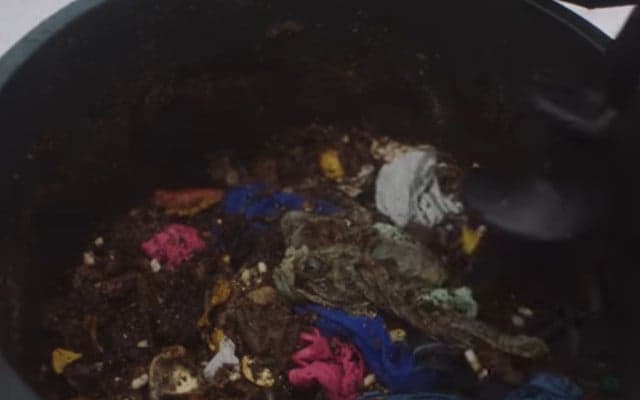This Swedish company proved you can eat your old clothes

Would you eat old clothes? That's exactly what one Swedish clothing brand asked a group of people to do when they created a fine-dining menu from food grown out of textiles, in an effort to prove a point about sustainability.
Outdoor apparel bran Houdini Sportswear wanted to demonstrate that their products are entirely natural, and came to the conclusion that the best way to do so was – in a roundabout way – by making people eat them.
"A couple of the collections turned out to be biodegradable, and from there we started to talk about what more you could do with old clothes. We felt the ultimate proof of what Houdini is and is working for is to show exactly how honest and transparent they are. What's more proof than to eat their old clothes?" a spokesperson from advertising agency McCann, which worked on the project with Houdini, told The Local.
Houdini collects worn out sportswear at its stores and will fix it without extra charge unless it's completely worn out, in which case they usually use it to make new items. This time however, they made food, achieving that by breaking the material down through composting.
With the soil that was created they then grew vegetables and herbs, and asked chef Sebastian Thureson to create "the world's first vegetarian fine-dining experience grown from old sportswear".
"The dinner took place at Agrikultur in Stockholm on April 23rd. We'd say the guests loved the food, thanks largely to chef Sebastian Thureson, but we want to believe the old clothes gave it that extra touch of uniqueness," McCann noted.
READ ALSO: The Swedes have made a jacket out of beans, wood and nuts
Houdini's menu made of clothes, as well as a fellow Swedish outdoor clothing company that proved they could make a jacket out of only beans, wood and nuts, are examples of an attention-grabbing approach to raising awareness about sustainability. So could that be the key to getting the message out there in the future?
"We don't think big problems have to have a boring solution, but we do think it's impossible to tell people what to care about or be interested in, so an interesting approach always helps," McCann said.
"It's starting to feel like a no brainer to consider what happens to our clothes after we are done using them, and how the process of making them affects both the people making them as well as the environment."
Comments
See Also
Outdoor apparel bran Houdini Sportswear wanted to demonstrate that their products are entirely natural, and came to the conclusion that the best way to do so was – in a roundabout way – by making people eat them.
"A couple of the collections turned out to be biodegradable, and from there we started to talk about what more you could do with old clothes. We felt the ultimate proof of what Houdini is and is working for is to show exactly how honest and transparent they are. What's more proof than to eat their old clothes?" a spokesperson from advertising agency McCann, which worked on the project with Houdini, told The Local.
Houdini collects worn out sportswear at its stores and will fix it without extra charge unless it's completely worn out, in which case they usually use it to make new items. This time however, they made food, achieving that by breaking the material down through composting.
With the soil that was created they then grew vegetables and herbs, and asked chef Sebastian Thureson to create "the world's first vegetarian fine-dining experience grown from old sportswear".
"The dinner took place at Agrikultur in Stockholm on April 23rd. We'd say the guests loved the food, thanks largely to chef Sebastian Thureson, but we want to believe the old clothes gave it that extra touch of uniqueness," McCann noted.
READ ALSO: The Swedes have made a jacket out of beans, wood and nuts
Houdini's menu made of clothes, as well as a fellow Swedish outdoor clothing company that proved they could make a jacket out of only beans, wood and nuts, are examples of an attention-grabbing approach to raising awareness about sustainability. So could that be the key to getting the message out there in the future?
"We don't think big problems have to have a boring solution, but we do think it's impossible to tell people what to care about or be interested in, so an interesting approach always helps," McCann said.
"It's starting to feel like a no brainer to consider what happens to our clothes after we are done using them, and how the process of making them affects both the people making them as well as the environment."
Join the conversation in our comments section below. Share your own views and experience and if you have a question or suggestion for our journalists then email us at [email protected].
Please keep comments civil, constructive and on topic – and make sure to read our terms of use before getting involved.
Please log in here to leave a comment.